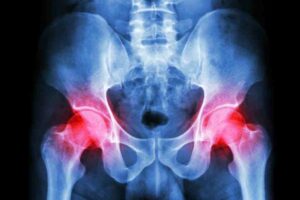If you are experiencing pain in your hip, you may have hip bursitis. This is a condition that occurs when the bursa, or fluid-filled sac, located near the hip joint becomes inflamed. Injury, overuse and infection have a chance to cause bursitis. In this blog post, we will discuss the causes, symptoms, and treatment options for hip bursitis.
Contents
What Is Hip Bursitis
 The acute inflammation of the bursae is known as bursitis. Your tendons, ligaments, and muscles are cushioned by the bursae, which are sacs filled with fluid. Bursae assist the tendons, ligaments, and muscles in moving across the bone smoothly when they function appropriately.
The acute inflammation of the bursae is known as bursitis. Your tendons, ligaments, and muscles are cushioned by the bursae, which are sacs filled with fluid. Bursae assist the tendons, ligaments, and muscles in moving across the bone smoothly when they function appropriately.
However, the region around the bursae becomes extremely tender and unpleasant when they swell. Trochanteric bursitis makes hip bursitis enlarge. Hip pain and stiffness may result from the inflammation. Bursitis is typically treated with rest and over-the-counter drugs and is not a life-threatening illness. Surgery may be necessary for severe bursitis situations to remove the affected tissue.
Symptoms Of Hip Bursitis

Hip discomfort, stiffness, swelling, and tenderness are all indications of hip bursitis. When you move in particular ways, like walking or leaning over to pick something up, the pain could get worse. Pain that worsens when performing tasks like getting out of a car or getting out of a deep chair.
Pain while applying pressure to the outside or inside of the hip. In order to receive a diagnosis and treatment plan, it’s critical to consult your doctor as soon as you notice these symptoms.
Common Causes of Hip Bursitis
Hip bursitis can be brought on by a variety of factors, such as overuse injuries, infections, and repetitive motions. Overuse of sports like cycling and jogging is one prevalent reason. These exercises cause the hip to move repeatedly, which can cause friction and inflammation in the bursae. Injury from a fall or other force to the hip region is another frequent cause. Poor posture will cause hip bursitis. Scoliosis, lumbar (lower) spine arthritis, and other issues with the spine can all contribute to this illness.
Treatment Options For Hip Bursitis
 Hip bursitis can be treated in a variety of ways, including:
Hip bursitis can be treated in a variety of ways, including:
- Ice – Every 4 hours, apply ice packs to your hip for 20 to 30 minutes each time. The area becomes numb from the cold, which can lessen discomfort as well as swelling and inflammation.
- Drugs that reduce inflammation – Pain and oedema can be reduced using over-the-counter analgesics such as ibuprofen (Advil, Motrin), naproxen (Aleve), and celecoxib (Celebrex), as well as prescription analgesics. Before ingesting them, though, make sure to consult your doctor.
- Rest – You can allow your hip to heal if you can avoid using it. Using crutches, walkers, and other aids could be beneficial.
- Physical therapy – With the assistance of a licensed therapist, you can perform exercises that will improve your flexibility and muscle strength.
Others call for a visit to the doctor’s office. They could consist of:
- Injections of cortisone – A potent anti-inflammatory drug is a cortisone. Athletes use this to lessen swelling and discomfort.
- Shock wave therapy with low energy – Using a focused instrument, sonic shock waves are sent through the skin. According to one investigation, after 4 months, more than two-thirds of patients who received shock wave therapy were either cured or significantly better.
- Surgery – Even though surgery is infrequently required, if the bursa cannot be repaired, it can be removed. Typically, it’s an outpatient operation, so there’s no need for an overnight hospital stay. Similar to routine knee and elbow procedures, a surgeon will utilize a camera-like device called an arthroscope along with small equipment.
These are just a few of the many options that can help you with hip bursitis. Do not forget to reach out to a professional in order to get a personalized treatment plan because each one has a different cause so treatment might differ. Get help today!
Physiotherapy For Hip Bursitis

Physiotherapy can heal swelling and discomfort of trochanteric bursitis. Although there is little research on the advantages of physical therapy or the techniques it employs, it is a typical approach when pain is a major concern.
- Assessing for any underlying diseases is crucial when a client’s primary complaint is `pain in order to treat them more successfully. Physical therapy can enhance joint mechanics, muscle strength, and flexibility as soon as these things are improved, pain lessens. The next step in treating trochanteric bursitis is to inject antiphlogistic medicine into the bursa (Corticosteroid-injections) factor.
- In case of persistent bursitis, surgery is the only option. The use of ultrasound, moist heat, instructing the patient on activity moderation, and fixing any potential training faults are further physical therapy procedures.
Stages To Recovery
- Managing the pain and inflammation is the first step. Trochanteric bursitis is mostly treated to relieve the discomfort, and two frequent methods include applying ice and taking non-steroidal anti-inflammatory medicines (NSAIDs). Ice therapy and methods or workouts that diminish the inflammation structures can be used to treat bursa inflammation. In addition, a physiotherapist may recommend various therapies, such as electrotherapy, acupuncture, taping methods, soft tissue massage, or the temporary use of a mobility device to offload the injured side.
- With the patient’s strength, the normal range of motion will return. Through a closely monitored and comprehensive exercise rehabilitation program, the physiotherapist will also enhance muscle strength and lying tension, proprioception, balance, and gait.
- The restoration of all functions is the following stage of rehabilitation. Numerous persons experience trochanteric bursitis as a result of routine daily activities like walking and running. The objective of the physiotherapist is to offer the patient a customized program to enhance movement and lessen discomfort, allowing them to carry out their everyday tasks more easily.
- Preventing a recurrence is the final step. To correct any biomechanical issues in the lower limbs, it could be as easy as strengthening your core muscles or creating foot orthotics. By treating any inadequacies in core strength and balance, the therapist will assess your hip mobility and function. He will also instruct the patient in basic self-management skills. The patient’s safe return to their previous sporting or recreational activity is the ultimate goal.
Risk Factors
Bursitis can affect everyone, but some things can make it more likely:
- Age – As people age, bursitis becomes increasingly prevalent.
- Hobbies or professions – Your risk of getting bursitis increases if your job or pastime requires repetitive movements or pressure on certain bursae. Examples include installing tile, laying carpet, growing plants, painting, and playing an instrument.
- Other health problems – Illnesses and ailments like rheumatoid arthritis, gout, and diabetes increase your chances to get hip bursitis. Having hip and knee bursitis is more likely if you are overweight.
Prevention

If you properly care for your hips as well as the rest of your body, you can prevent trochanteric bursitis from worsening or even developing at all. Among your options are:
- Exercise correctly. Being active is fantastic, but you must train properly. This entails warming up, stretching, and paying attention to your body.
- Put on the right inserts or orthotics. One leg being shorter than the other is a contributing factor in trochanteric bursitis.
If you’re overweight, lose some weight. It will undoubtedly relieve stress on your hips.
Conclusion
As a result of trauma, overuse, or certain underlying medical disorders, hip bursitis can become a very painful condition The primary signs and symptoms of this illness are tightness and stiffness, combined with pain and inflammation in the affected area. Treatment methods might range from straightforward rest and ice therapy to more rigorous physical therapy depending on the extent of the injury.
Therefore, you should not delay your need for treatment, it might cause you severe injuries. With the right intervention, you can have a healthy life!
Physical Therapy help patients recover from pain. If you’re experiencing Back pain, Shoulder pain, Knee pain, Neck pain, Elbow pain, Hip pain, or Arthritis pain, a physical therapist at MantraCare can help: Book a physiotherapy session.


